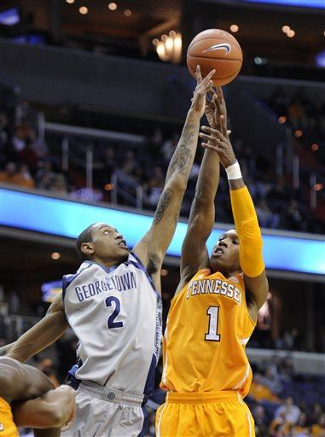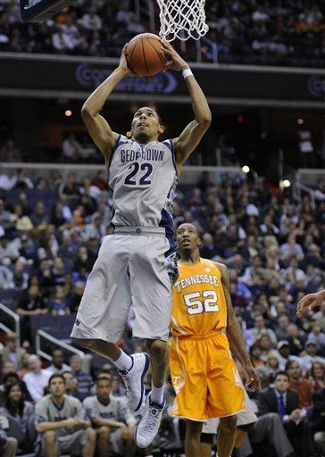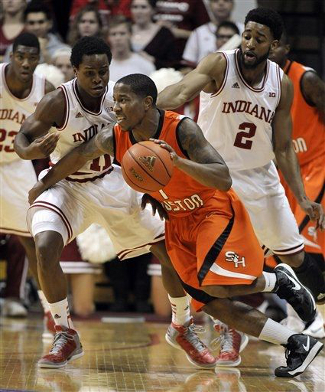Madison Square Garden | New York, NY | Tip: 6 P.M. CT | TV: ESPN LRT Consecutive Game #228 Since suffering a shameful loss at the hands of Division II Chaminade on the island of Maui, the Longhorn defense has been downright stingy. After the Silverswords lit up the Texas D for 1.11 points per possession, the team has allowed just .740 points per possession in its last four games, and hasn’t allowed a single opponent to score more than .853 per trip. With their D-II loss not factoring into team statistics, the Longhorns now have the third-most efficient defense in the country, and have the best defensive mark in effective field goal percentage. While the numbers are dominant, they haven’t come against a gauntlet of juggernauts. Mississippi State, Sam Houston State, and UT-Arlington are all averaging less than .9 points per possession on the season, with Southern Cal’s .95 not much better. Tonight’s game against a very talented and versatile Georgetown team will be the first true test for the Longhorn defense, and is only the beginning of a daunting stretch. Texas faces UCLA, North Carolina, and Michigan State in the next three weeks. By the numbers The Hoyas are known for their Princeton sets under Coach John Thompson III, and that patient offensive philosophy leads to some low-possession, low-scoring affairs. Georgetown has an adjusted pace of just 63.5 possessions per game so far this year, a tempo that puts them among the 40 slowest teams in D-I. On Friday night, Georgetown and Tennessee combined a 54-possession game with some terrible shooting to provide a glaucoma-inducing 37-36 final.
Georgetown’s length has frustrated opponents all season While the Hoyas mix in some traps and use a quick, active 2-3 zone to pressure opponents, they don’t typically force a ton of turnovers. Georgetown opponents have only given it up on 20.1% of their possessions, just a bit below the national median of 21.1%. Despite not forcing mistakes, the Hoyas still have a solid defense that is ranked 20th nationally in efficiency. As Texas fans know all too well, these young Longhorns have had far too many careless turnovers this season. Against a defense that is already oppressive even without the aid of turnovers, the Horns cannot afford to frequently waste their possessions with lazy or inaccurate passes. Although Georgetown starts four players that are 6’8″ or taller, their offense does a poor job at extending possessions with rebounds. With their offensive sets often stretching the D across the floor, the Hoyas aren’t usually in position to crash the boards. As a result they have only won 23.3% of their offensive rebounding opportunities, ranking them just 333rd out of 347 D-I teams. On the other end of the court, Georgetown is dominant on the glass. Opponents reclaim just 26.8% of their missed shots, a stat that is even more impressive when you consider how often the Hoyas use a 2-3 zone on defense. Without any specific box-out assignments in the zone, those kind of defensive rebounding numbers are very difficult to achieve. Meet the Hoyas Georgetown uses a balanced attack on the offensive end, as four of their starters average more than 10 points per game. The starting five features four players who are 6’8″ or taller, and all four of them are athletic, versatile players who can switch easily on defense and play a variety of roles in the smooth-flowing offense. The one starter who doesn’t eclipse that 6’8″ mark is junior guard Markel Starks (No. 5), who checks in at 6’2″. While Starks can go quiet for long stretches, he heats up in a hurry and can score from anywhere on the court. He’s hit more than 44% of his three-point attempts this season, but will also put the ball on the floor to blow by defenses when they close out hard on the perimeter. In two games at the Legends Classic in Brooklyn, Starks lit up for 43 points against UCLA and Indiana, hitting 4-of-7 from beyond the arc against the Hoosiers. Even though Starks typically brings the ball up the floor, big man Greg Whittington (No. 2) can also handle the basketball. He’s surprisingly deft with the ball for a 6’8″ guy and can play any position from one through four. Whittington has a nice midrange game and can quickly knock down a shot with very little space, but he can also beat defenders off the bounce when they are overzealous with the ball pressure. The sophomore is also doing a beastly job on the glass, averaging nearly nine boards per game. Even when he’s out of position, it seems that Whittington seems to glide through traffic to snatch rebounds out of the air. Thanks to the length throughout the Georgetown lineup, Whittington also often gets the chance to take advantage of his size on the offensive end, as many teams have to use smaller shooting guards to defend him. On the very first possession of the Indiana game, Whittington drove the ball against 6-footer Jordan Hulls, forcing immediate help defense and rotations from the Hoosiers. With opposing bigs unable to keep up and opposing guards too small to shut him down, Whittington is averaging a team-leading 12.7 points per game.
Otto Porter is expected to have a big season for the Hoyas The biggest star on the roster is sophomore Otto Porter, Jr. (No. 22), who is primed for a breakout season. After starting nine games in his freshman campaign, Porter was named to the Big East preseason first-team this year. He has a great jumper that’s accurate even out to three-point range, and he is an impressive passer for a big man. With an offense predicated on backcuts, post-ups, and flares, that ability to quickly and accurately find a teammate is paramount. Porter is actually second on the team with 14 dimes, giving him an excellent assist rate of more than 22% early in the season. The team leader in assists is 6’8″ Nate Lubick (No. 34), who has 16 so far this year. While Lubick has always been a great passer out of the high post, the Hoyas are looking for some more confidence this year when it comes to his shooting. The junior has filled that role so far, often popping it from the elbow when defenses sag off of him to take away the passing angles. Although those midrange jumpers aren’t falling consistently yet, his looks from the blocks have kept his shooting percentage at a nice 57.1% mark. The tallest member of the starting five is 6’9″ sophomore Mikael Hopkins (No. 3). Hopkins is yet another versatile player for Coach Thompson, as he can knock it down all the way out to the perimeter. Although he’s 0-for-1 from three-point range this season, he did sink an early bucket against Indiana with his feet on the arc. That shooting threat coupled with above-average handles also give Hopkins the ability to take opposing bigs in face-up situations from the mid-range. Even though he can shoot it and put the ball on the deck, the main role for Hopkins is that of the go-to post player. He has so many good post moves in his repertoire, but so far this season, he has been struggling to hit the great looks he earns. If and when the sophomore can start consistently making his shots from within a few feet of the rim, he is going to be a big-time scorer for the Hoyas. With such a solid starting five, Georgetown really only relies on two key bench contributors, D’Vauntes Smith-Rivera (No. 4) and Jabril Trawick (No. 55). Smith-Rivera is an exciting freshman guard who is a very stout 6’3″ that can finish through contact inside. He’s also an outside shooting threat, as evidenced by his collegiate debut against Duquesne, where he knocked down all four of his three-point tries. At 6’5″, Trawick allows Coach Thompson to still retain a size advantage against most standard lineups. Like his teammates, Trawick is a good shooter that can hit from anywhere, and his burst with the ball makes him a constant threat to get to the rack. In that ugly win over Tennessee, Trawick’s brief scoring surge in the second half was one of the lone bright spots for the Hoya offense. Stephen Domingo (No. 31) also has made an appearance in every game so far, but only averages a few minutes per contest. The freshman arrived at Georgetown ahead of schedule after finishing his high school requirements early and skipping his senior year. He was a Top 100 recruit in the Class of 2013 before reclassifying, and impressed as a starter on the USA’s U17 team at the World Championships in Lithuania. Keys to the game 1) Communicate on defense – No matter how the Longhorns choose to tackle this Georgetown offense, good communication and quick help will be key. The Hoya offense has looked stagnant against zone defenses this year, often just swinging the ball around the perimeter instead of getting it into the high post. Although the offense has come a long way since facing Florida’s zone in The Game That Never Was on the USS Bataan, but the Hoyas still look much better against the man. The Longhorns certainly have the length available to match up with the Hoyas in a man-to-man look, but that would mean giving more minutes to the likes of Prince Ibeh and Connor Lammert, while taking their best shooter off the floor in Julien Lewis. While it’s highly unlikely that those two bigs could keep up with the likes of Porter and Whittington, it’s even more unlikely that Cameron Ridley could handle extended minutes playing against a player who can stretch the floor like Hopkins. Rick Barnes has favored the zone so far this year, and it looks like that’s the best approach against this Hoya lineup. That means that Texas will have to communicate as they pass the cutters off and that the Horns will need to find somebody to box out in defensive rebounding situations. 2) Value the basketball – As previously mentioned, the Hoya defense does a very good job at shutting down opponents without the benefit of turnovers. Unfortunately, the Longhorns have helped out their opponents by turning it over very frequently, and oftentimes without much pressure from the defense. Texas has to avoid those types of careless mistakes tonight in a low-possession game against a defense that doesn’t need any help. The Horns must squeeze every point they can out of their possessions, and throwing bad passes to some New Yorker on the front row will quickly sink their chances of an upset. 3) Move the ball – The Texas offense has looked rejuvenated over the last few games, with good motion off the ball and great passing to find the open man. With Javan Felix not having to dribble the air out of the ball while teammates stand around, the Longhorn offense hasn’t wasted time or possessions, and shooting percentages have skyrocketed. This Hoya defense is going to make the Longhorns knock down shots, so they will have to use that same approach to get open looks and make them count. When you also consider that the Longhorns have scored nearly 24% of their points from the line this season, while the Hoyas are one of the best in the country at not sending opponents to the charity stripe, it’s clear that Texas will have to score from the floor. Good ball movement can make that happen, while stagnant, clock-burning possessions will only result in challenged jumpers and desperation heaves. |











